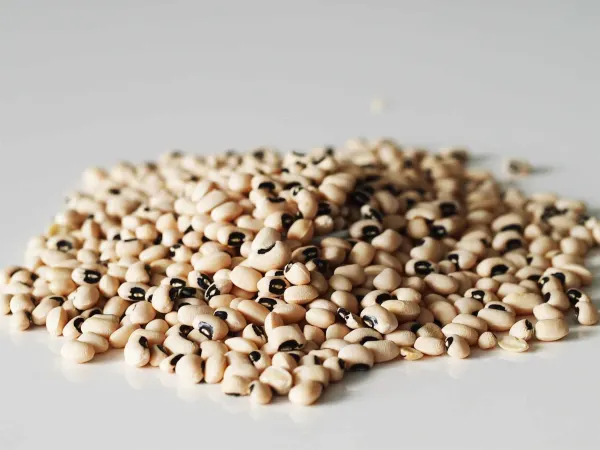Black-Eyed Peas
Legume
Age Suggestion
6 months
Iron-Rich
Yes
Common Allergen
No

When can babies eat black-eyed peas?
Black-eyed peas may be introduced as soon as your baby is ready to start solids, which is generally around 6 months of age.
Background and origins of black-eyed peas
Despite their name, black-eyed peas are actually beans, and they are among the most nutritious plant-based foods you can offer your child. There are hundreds of varieties that vary in size and color, but the California Blackeye is the most popular. The small cream-colored bean with a black “eye” is also called a cow pea and a field pea—names that hint at the history of the plant. Black-eyed peas were a favored crop on farms in the American South and Caribbean islands, where black eyed peas traveled along with enslaved people from West Africa, the bean’s native land. Today, the black-eyed peas are a popular staple food in many cultures as well as a celebratory ingredient that symbolizes good luck and prosperity.
Videos
Are black-eyed peas healthy for babies?
Yes! Black-eyed peas are one of the most nutritious plant foods you can offer your baby. They have a ton of calcium and protein, folate (for healthy blood), vitamin A (for eye, immune, and skin health), and zinc, which supports the immune system. But their true superpower: these little legumes are packed with iron, an essential nutrient that helps transport oxygen in the body.
Babies need increasing amounts of iron starting at around 6 months, when their reserves from being in the womb become depleted. This is why, for example, iron-fortified rice cereal for babies is sometimes recommended by pediatricians. But bland, textureless rice cereal need not be baby’s first food. There are plenty of whole foods that are naturally high in iron—like black-eyed peas—that can easily be worked into your baby’s diet. Tip: Serve iron-rich foods like black-eyed peas alongside fruits and vegetables high in vitamin C, which boosts your baby’s ability to absorb the critical nutrient.
Cooking dried black-eyed peas from scratch is more economical (and usually healthier!) but canned beans taste great, too. Just be sure to read the fine print on the labels:
Watch the salt. From beans to fish, canned products often have exceedingly high levels of sodium, which you want to limit when it comes to feeding your baby. Beans and black eye peas in cans marked “no salt added” or “low sodium” are safe options.
Be careful with BPA. Bisphenol A (BPA) is a chemical used in plastics and resins, and in the interior lining of cans, amongst many other packaging materials. Unfortunately, BPA has been linked to cellular damage, including disrupting your baby’s endocrine (hormone) functions, affecting growth in many ways. When purchasing preserved products for your baby, look for cans and containers that are marked “BPA-free”.
Are black-eyed peas a common choking hazard for babies?
No. Once cooked, black-eyed peas are not a common cause of choking. That said, in theory an individual can choke on any food. Always remain within an arm’s reach of your baby during mealtime.
For more information, visit our section on gagging and choking and familiarize yourself with common choking hazards.
Are black-eyed peas a common allergen?
No. However, it’s not impossible: there are some populations with legume allergies.
As with all new foods, start by introducing a small amount for the first couple of servings and watch closely. If there is no adverse reaction, gradually increase the serving size over future meals.
How do you prepare black-eyed peas for babies with baby-led weaning?
Every baby develops on their own timeline, and the suggestions on how to cut or prepare particular foods are generalizations for a broad audience.
6 to 9 months old:
At this age, the easiest way to serve black-eyed peas is to make a mash. See our recipe, which can be served on its own to encourage your baby to hand-scoop. As an alternative, you could spread the mash on a thin rice cake or baby cracker.
9 to 12 months old:
This is a good age to start offering whole, cooked beans on their own to encourage your baby to practice the pincer grasp. You may, of course, also continue with mashed beans on thin rice cakes or on their own.
12 to 24 months old:
Use black-eyed peas widely in your cooking! Encourage your baby to use age-appropriate utensils and explore a variety of sauces and presentations.
Soak beans overnight with a little apple cider vinegar or lemon juice before cooking to help break down bothersome plant compounds and make them more digestible.
For more information on how to cut food for babies, visit our page on Food Sizes & Shapes.
Written and reviewed by these specialists
Expert Tips Delivered to Your Inbox
Sign up for weekly tips, recipes and more!
The content offered on SolidStarts.com is for informational purposes only. Solidstarts is not engaged in rendering professional advice, whether medical or otherwise, to individual users or their children or families. No content on this site, regardless of date, should ever be used as a substitute for direct medical advice from your doctor or your medical or health professional, nutritionist, or expert in pediatric feeding and eating. By accessing the content on SolidStarts.com, you acknowledge and agree that you are accepting the responsibility for your child’s health and well-being. In return for providing you with an array of content “baby-led weaning” information, you waive any claims that you or your child may have as a result of utilizing the content on SolidStarts.com.



